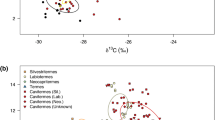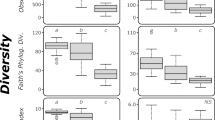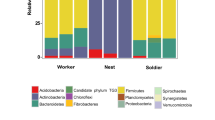Abstract.
While recent results have provided strong evidence for the presence of a stable gut microbiota among several termite species, little is known about variations at the colony or individual level. Using a cultivation-independent approach, we investigated the structure of the bacterial community in the gut of termites from four different colonies of Hodotermes mossambicus. 16S rRNA-based terminal restriction fragment length polymorphism (T-RFLP) analysis of the bacterial gut microbiota revealed (1) a high consistency of the gut microbiota among nestmates and (2) subtle but distinct differences in community structure between individuals from different colonies. Since products of bacterial metabolism may contribute to a colony odor that can be used as discriminatory signal, the presence of a colony-specific bacterial community adds support to the hypothesis that the gut microbiota of termites is involved in nestmate recognition.
Similar content being viewed by others
Author information
Authors and Affiliations
Corresponding author
Additional information
Received 12 July 2005; revised 10 February and 15 March 2006; accepted 7 April 2006.
Rights and permissions
About this article
Cite this article
Minkley, N., Fujita, A., Brune, A. et al. Nest specificity of the bacterial community in termite guts (Hodotermes mossambicus). Insect. Soc. 53, 339–344 (2006). https://doi.org/10.1007/s00040-006-0878-5
Issue Date:
DOI: https://doi.org/10.1007/s00040-006-0878-5




